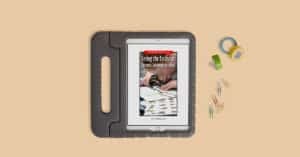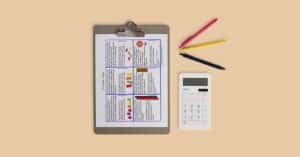I absolutely loved chatting with you about curriculum-based therapy at the SLP Summit this week! There’s nothing better than getting to hang out with thousands of you! I am so inspired by your passion and dedication to your students!
Haven’t heard of the SLP Summit? Sarah and Lisa from SLP Toolkit and I host a FREE online conference for SLPs, featuring practical tips and resources for SLPs to start the school year off on the right foot!
You asked so many fabulous questions, and I wanted to take a minute to answer them here! 🙂
How do you put everything together?
Here’s a peek at how I streamline the entire process!
Step 1: Know Your Goals
Do you have specific language goals that work well with CBT?
I don’t! When we are implementing curriculum-based therapy, we are still addressing the same language underpinning. The only difference is that we use materials from the classroom as the “vehicle” to practice those skills.
This is a lot easier when we have a comprehensive evaluation to pull from. We should not write goals based solely on performance on a standardized test. We want to make sure that we’re considering parent and teacher input, language samples, classroom observation, curriculum-based assessments, etc. when writing goals for our students.
Step 2: Build Your Curriculum
How do you organize your materials?
I use a therapy tote! Here’s a quick overview of how I put it together.
How do you recommend building/organizing the core materials for teletherapy? Should we have on-site facilitators print, laminate, etc., or is there a better alternative for using the materials digitally?
Check out this post for some ideas.
What is the best way to identify vocabulary by tiers?
VocabGrabber is a great tool that can help you identify vocabulary by tier!
Tier 1 = High familiarity words, Tier 2 = Vocabulary, Tier 3 = Geography, Social Studies, Math, etc.
Step 3: Gather Classroom Materials
How do you go about starting to do Curriculum-Based Therapy?
Check out the Teacher Communication Starter Kit!
Do you reach out to the teachers each week to see what they are working on in order to incorporate it into your sessions?
I don’t typically reach out to teachers every week. I do quick check-ins as I see the teacher on campus, but I do make a point to touch base monthly. I work with the teacher to identify 1-2 activities to focus on for the month.
How do you go about scheduling collaboration time with teachers?
This has looked different in every school! I may check in with teachers before/after school, during their planning periods, before/during/after staff meetings, or during teacher collaboration time.
How do you deal with resistant teachers? How do you begin to open the door for conversation that this is more relevant and will help their students with all areas?
You could approach this in a number of ways.
You could start with less resistant teachers. Teacher inevitably talk, and word will spread that you’re doing amazing things! This is a great option if you’re not as confident yet.
If you’re willing to be a little more persistent, these strategies have worked for me:
- Ask teachers about their goals (and offer to support). Teachers can use collaborating with you as “evidence” when being evaluated.
- Ask specific questions about what they’re doing in a certain subject (e.g., “What are you reading next week?”).
- Ask how the students on your caseload are doing in the classroom. Teachers always have something to say about that!
I was placed at a school that had a reputation (district-wide!) for having the most challenging staff. I was able to implement this with all of the teachers, so it is totally doable!
How do you go about this when you have a group of students who are all from different classes and the teachers are doing different books, etc.?
When I schedule my caseload, I try to schedule students by teacher and/or grade. Mixed groups work really well for curriculum-based therapy!
The only exception is students who only have articulation goals. I try to schedule those students separately.
Do you identify a variety of goals for each student with their teacher? Are you working on the same thing as the teacher?
I work with teachers to identify the “context” for therapy (e.g., a social studies text, a math problem, a science project). We target all goals in the context of those activities.
Step 4: Increase Goal Awareness
If a student has multiple goals, do you make multiple goal cards?
I do! I create one card for each goal.
How do you approach reviewing goals at the beginning of the year/session for verbal students who may be lower cognitively and ALSO have significant difficulty with reading and writing?
What will help the student most? The good news is that we have a lot of different options here. If the student is unable to write, then the student can draw a picture. I might create a simple visual for the student. Another option is to take a picture of them working on the skill. (This works especially well for more functional goals.)
Step 5: Engage Students
How do you motivate students in grades 4-6 who rush through writing/language activities to get them done instead of taking time to use/show their true skills?
I find that student engagement increases when they have a strong understanding of their goals and can explain why those goals matter. We may switch things up by writing on the table with a dry erase marker, using erasable highlighters, or reading passages on the iPad, but I find that I don’t need a lot of extra “fluff” once students understand the why behind their goals.
Step 6: Collect Data
How do you organize your data collection?
I use SLP Now. (You can try it for free!)
Aaaaaand that’s a wrap! Feel free to comment below with any questions that I missed!




Reader Interactions